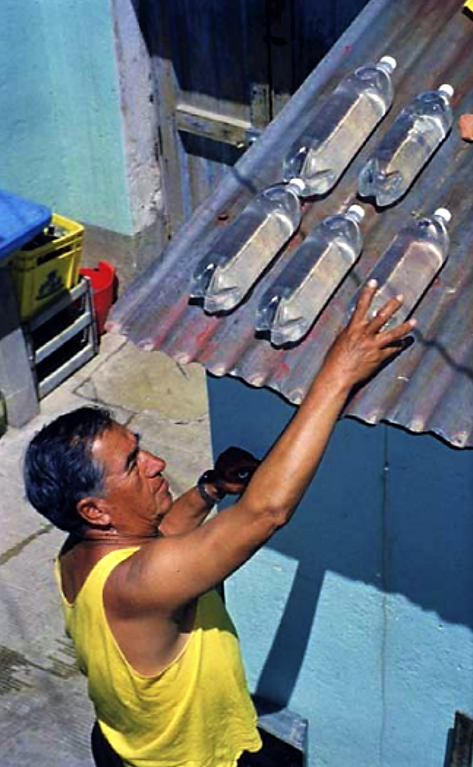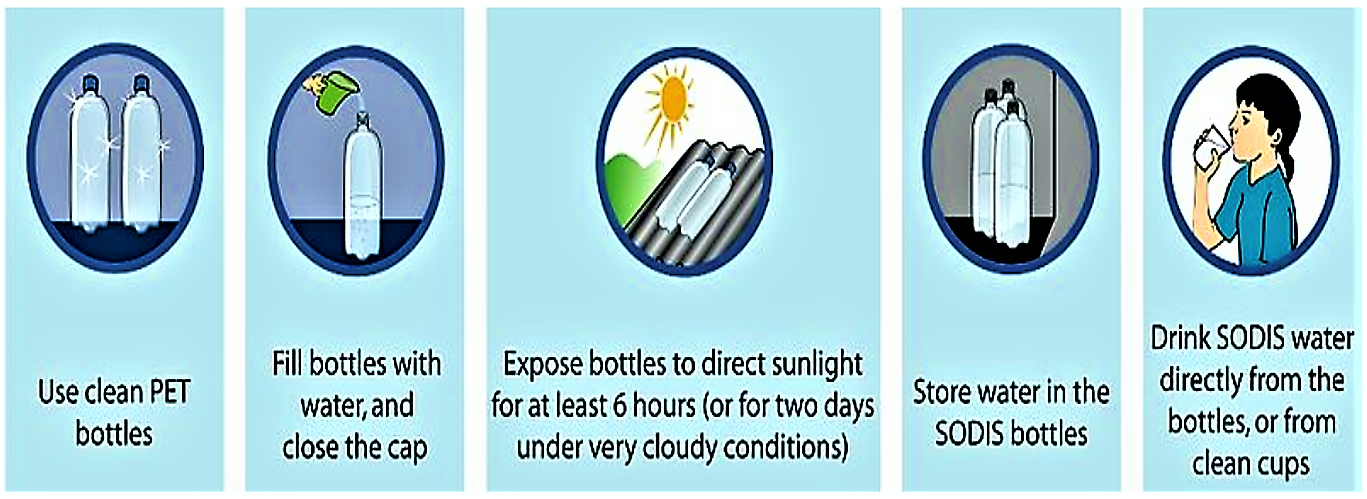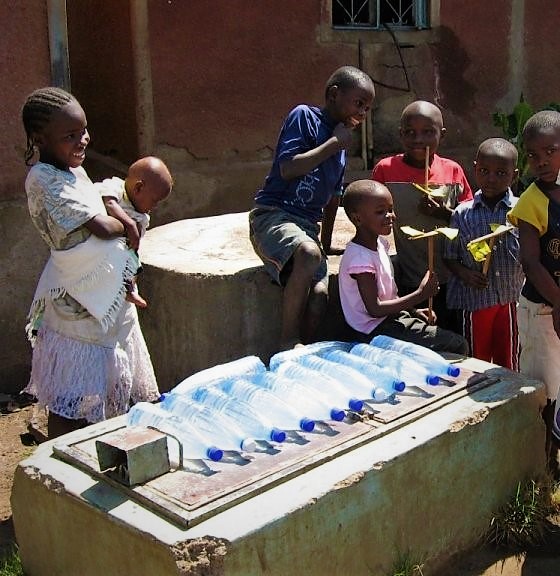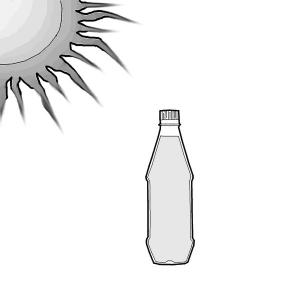Resumen ejecutivo
When microbially polluted water is exposed to solar light in transparent PET bottles, bacteria, virus and some parasites are inactivated by the solar UV-A radiation. 1 to 2 litres of water are filled into clean bottles and exposed to the sun for at least 6 hours if the sky is bright. UV-A radiation is strongly attenuated by clouds; furthermore, turbidity or water depth protects the pathogens from UV-A radiation. Hence the process depends strongly on the local climate, and only low volumes with relatively low turbidity can be treated at a time. SODIS is extremely low-cost and simple and is one of the WHO recommended household level water treatments. However, chemical pollution (e. g. arsenic, fluoride, agricultural residues) cannot be removed by solar disinfection (SODIS).
| Entradas | Salidas |
|---|---|
Drinking Water |
Introduction
Solar Water Disinfection (SODIS) is a simple water treatment technology that can be used at household level. As a point-of-use water purification method, SODIS improves the microbiological quality of drinking water with solar radiation at almost zero investment and maintenance costs. Today, SODIS is one of the recommended household level water treatment technologies by the World Health Organisation (WHO).
PET (Polyethylene terephthalat) bottles or plastic bags with a volume of 1 to 2 litres are filled with water of low turbidity and exposed to the sun for a certain time, depending on the local weather conditions. The SODIS reference centre (www.sodis.ch) recommends, that 6 hours are sufficient under bright to 50% cloudy sky, whereas 2 days of exposure are required for 100% cloudy sky (OATES 2003, EAWAG/SANDEC 2006). The treatment efficiency can be improved if the plastic bottles are exposed on sunlight-reflecting surfaces such as aluminium- or corrugated iron sheets (MEIERHOFER 2002). During periods of continuous rainfall, SODIS does not perform satisfactorily and rainwater harvesting is recommended during these days.

SODIS process
UV-B light (280 to 320 nm) can directly be absorbed by DNA, leading to damage, but only 1% of natural solar light is of this type. Hence, sunlight used during the SODIS process consists mainly of UV-A light (320 to 400 nm), which makes 6% of the total solar light. This light can be absorbed by molecules, which are naturally present in the water. When these molecules (called photosensitizers) have absorbed the energy, they can pass it to the oxygen in the surrounding water, leading to the formation of reactive oxygen species (ROS). ROS include free radicals such as the superoxide anion as well as non-radicals such as hydrogen peroxide. ROS damage the membranes proteins, enhancing the oxidative stress of the cell and accelerating their aging process (BOSSHARD, 2009). But ROS can also lead to some DNA damage, such as single strand breaks and nucleic base modifications, which may be lethal and mutagenic. This type of pathogen inactivation Is called photooxidative stress. Photo- because it is the light which generates ROS, and oxidative stress, because these reactive oxygen species (ROS) lead to stress.
When the water temperature reaches more than 45°C, a synergistic effect of UV-A radiation (optical inactivation) and infrared light (thermal inactivation) is observed. At increased water temperatures, the exposure time needed to disinfect the water is reduced. But during cloudy weather conditions, the solar infrared light is reduced and bottles need to be exposed for 2 days to guarantee that the radiation dose received is sufficient to disinfect the water.
In contrast to infrared light (heat), UV-A radiation is only slightly attenuated by clouds. But turbidity in the water reduces the amount of UV radiation that penetrates the water. Therefore, the containers used for SODIS should be relatively flat (i.e. not exceed a depths of 10 cm). Water turbidity can easily be determined: Place the full bottle on a newspaper headline (the letters should have a size of about 1.5 cm) and look through the bottle from top to bottom. Water turbidity is less than 30 NTU if you can read the letters through the water. If not, the water must be filtered first so that SODIS will work.

Suitable containers
Suitable containers for SODIS are PET or glass bottles. Ordinary window glass is almost opaque to UV light and cannot be used to construct SODIS containers. The use of PVC bottles is not recommended. It is normally marked on the bottle whether it is PET or PVC, however, the labels vary from country to country. PET and PVC bottles are normally marked accordingly. The labels can vary from country to country, though. If the bottles are not marked, you can only tell the difference between the bottles by setting fire to them. PET burns quickly and easily when it is held in a flame. When it is taken out of the flame, the fire goes out slowly, or it may keep burning. The smoke smells sweet. PVC does not burn easily. The material does not burn at all when not in the flame. PVC smoke smells acrid. Heavily scratched or old PET bottle should be replaced regularly as the scratching makes them opaque.

Use of SODIS
Today, over 4 million people of the world do drink SODIS treated water. To establish a successful application of SODIS, it is important to implement a comprehensive education and training program aiming at creating awareness and establishing a sustainable behaviour change accordingly. Important factors that support project success are: the local availability of PET-bottles and interventions that support the take-up of a certain behaviour, such as education and awareness creation (for example through using participatory methods such as PHAST), motivation and the use of convincing & emotional arguments. Tools applied in this phase are training through motivated health workers of groups and individual households, dissemination of information materials, demonstrations, demonstration of water quality tests, fun during educational events (songs, theatres, etc.), and education in schools. Generally, one year after project implementation, 20-80% of the trained people use SODIS on a regular basis (MEIERHOFER 2009).
After the practice has been established in a community, it is necessary, to implement interventions that support the continued practice of the behaviour and establish a habit such as regular household visits, tools that remind people of treating the water, mass media campaigns, regular application in schools etc.
Health impacts
The health impact of SODIS has been evaluated during several epidemiological health impact studies in various countries, which demonstrated that using SODIS for water treatment could reduce the diarrhoea incidence of children below five years of age between 16 and 88% (CONROY 2001; ROSE 2006, HOBBINS 2004, GRAF 2008; MAEUSEZAHL 2009). The health impact that can be achieved by a SODIS intervention depends on the following factors:
- The initial (microbial) quality of the water source: the impact is higher if the intervention community consumed highly contaminated water prior to the intervention.
- The general sanitary situation and hygiene practices in the community (e.g. presence of latrines and hand washing with soap): Diarrhoeal diseases are not only transmitted through drinking water. Therefore, the health impact of a drinking water intervention is limited if a community does not have latrines and proper hygiene practices.
- The percentage of safe drinks consumed by a user: A significant health impact can only be achieved if the consumption of unsafe drinks is avoided completely!
- SODIS is not a replacement of the access to safe drinking water, as it is required to reach the millennium development goals, but a simple and extremely low cost method to improve the microbial quality of drinking water at household levels. Large volumes cannot be provided with the use of this method.
- SODIS can be used in both rural areas and urban slums, but PET bottles are generally more available in urban regions.
- SODIS cannot treat water that is chemically polluted (e.g. arsenic, fluoride or industrial and agricultural organic contaminants). SODIS is very well adapted as a secondary treatment of water coming from an improved source (e.g. well water), which does not meet the microbial quality standards.
- As SODIS requires a consistently sunny climate and solar irradiation, it is most suited for regions within latitudes of 15°N/ S and 35°N/ S. Turbidity can deteriorate the effect and if the latter is higher than 30 NTU, pre-filtration is required.
- As SODIS is extremely low cost, it is adapted for population with little income. However it should not be sold as a method for the poor as this could lower the attractivity of SODIS as people don't like to be labeled as 'poor'.
- To distribute PET bottles for free will not result in a sustainable application. The integrated promotion together with other household-level drinking water treatments (e.g. chlorination, filtration) to give people the option to make a choice, seems the most promising.
- It is also recommended to combine SODIS with other interventions to improve the health, sanitation and hygiene situation. This approach allows also working in close collaboration with governmental or other large-scale interventions
Solar Disinfection of Drinking Water Protects against Cholera in Children under 6 Years of Age
Home-Based Water Purification through Sunlight: from Promotion to Health Effectiveness
Solar Disinfection of Water for Diarrhoeal Prevention in Southern India
Water Disinfection and Hygiene Behaviour in an Urban Slum in Kenya: Impact on Childhood Diarrhoea and Influence of Beliefs
Solar Drinking Water Disinfection (SODIS) to Reduce Childhood Diarrhoea in Rural Bolivia: A Cluster-Randomized, Controlled Trial
Solar Water Disinfection: A Guide for the Application of SODIS
Factors Supporting the Sustained Use of Solar Water Disinfection - Experiences from a Global Promotion and Dissemination Programme
Training Material for SODIS Promotion
Extensive handbook for the implementation of SODIS projects and giving an introduction in the training of technical staff, promoters and users.
EAWAG/SANDEC (2006): Training Material for SODIS Promotion. pdf presentation. Duebendorf: Water and Sanitation in Developing Countries (SANDEC) at the Swiss Federal Institute of Aquatic Science and Technology (EAWAG) URL [Visita: 17.03.2010]Solar disinfection (SODIS): Simulation of Solar Radiation for Global Assessment and Application for Point-of-Use Water Treatment in Haiti
Water disinfection: Assessment and Application. Ottawa
This internet book gives an overview of the technical parameters to understand how solar water disinfection works.
ACRA, A. ; JURDI ; MU'ALLEM, H. ; KARAHAGOPIAN, Y. ; RAFFOUL, Z. (1990): Water disinfection: Assessment and Application. Ottawa . Entradas: International Journal of Environmental Health Research: Volume 18 , 335. URL [Visita: 27.01.2010]Preventing Diarrhoeal Disease in Developing Countries: Proven Household Water Treatment Options
One-page introduction to main household water treatments methods, and further reading links.
CDC/USAID (2008): Preventing Diarrhoeal Disease in Developing Countries: Proven Household Water Treatment Options. Atlanta and New York: Center for Disease Control and Prevention (CDC) and United States Agency for International Development (USAID) URL [Visita: 15.03.2010]Household Water Treatment Options in Developing Countries: Solar Disinfection (SODIS)
CDC paper on the implementation of SODIS.
CDC (2008): Household Water Treatment Options in Developing Countries: Solar Disinfection (SODIS). pdf presentation. New York: Center for Disease Control and Prevention URL [Visita: 15.03.2010]Household water treatment and safe storage in emergencies
This document is intended as a general manual on household water treatment and storage in emergencies. Methods of treatment but also promotion are presented, including factsheets, a decision tree and very comprehensive illustrations.
IFRC (2008): Household water treatment and safe storage in emergencies. pdf presentation. Geneva: International Federation of Red Cross and Red Crescent Societies (IFRC) URL [Visita: 23.04.2012]Solar Water Disinfection: A Guide for the Application of SODIS
Smart Disinfection Solutions
This booklet, part of the Smart Water Solutions series provides a wide range of methods and products for home water treatment in rural areas.
NWP (2010): Smart Disinfection Solutions. Examples of small-scale disinfection products for safe drinking water. (= Smart water solutions ). Amsterdam: KIT Publishers URL [Visita: 17.05.2019]SODIS – an Emerging Water Treatment Process
This article comprises the work of several research teams which analysed the effectiveness of SODIS in various laboratory and field investigations.
SOMMER, B. ; MARINO, A. ; SOLETE, Y. ; SALAS, M.L. ; DIEROLF, C. ; VALIENTE, C. ; MORA, D. ; RECHSTEINER, R. ; SETTER, P. ; WIROJANAGUD, W. ; AJARME, H. ; AL-HASSAN, A. ; WEGELIN, M. (1997): SODIS – an Emerging Water Treatment Process . Entradas: Journal of Water Supply: Research and Technology - Aqua: Volume 46 , 127. URL [Visita: 17.05.2019]Promotion of household water treatment and safe storage in UNICEF WASH programmes
Short introduction to household water treatment and the main treatment methods.
UNICEF (2008): Promotion of household water treatment and safe storage in UNICEF WASH programmes. pdf presentation. New York: United Nations Children's Fund URL [Visita: 17.03.2010]Household Water Treatment and Safe Storage Following Emergencies and Disasters
A six-pages compilation about what to do in emergency situations. Designated to the South Asia earthquake and tsunami.
WHO (n.y): Household Water Treatment and Safe Storage Following Emergencies and Disasters. pdf presentation. Geneva: World Health Organisation (WHO) URL [Visita: 17.05.2019]Conservation et Traitement de l Eau a Domicile
This practical guide provides a review of different processing techniques and adequate water conservation at home and is structured around 10 key questions that should be posed before choosing a suitable solution.
DESILLE, D. (2013): Conservation et Traitement de l Eau a Domicile. Paris: Programme Solidarite Eau (PSeau) URL [Visita: 06.06.2013]SODIS - Water quality improvement at household level. A case example from Tamil Nadu, India
LEAD, a local women’s organisation, promotes SODIS for the treatment of drinking water at household level, making use of its existing network of sangams (women self-help groups). In addition, teachers and students of local schools are trained. For the supply of PET-bottles, a micro-credit system was implemented.
League for Education and Development, LEAD (n.y): SODIS - Water quality improvement at household level. A case example from Tamil Nadu, India. (= SODIS Project Case Study ). Tamil Nadu, India: EAWAG/ SANDECSODIS - Water Quality improvement at Household Level. A case example from Kenya
LEAD, a local women’s organisation, promotes SODIS for the treatment of drinking water at household level, making use of its existing network of sangams (women self-help groups). In addition, teachers and students of local schools are trained. For the supply of PET-bottles, a micro-credit system was implemented.
EAWAG/SANDEC (n.y): SODIS - Water Quality improvement at Household Level. A case example from Kenya. (= SODIS Project Case Study ). Kenya: EAWAG/ SANDECSODIS – Water quality improvement at household level. A case example from Peru
After an earthquake that struck the region of Arequipa, the existing water distribution network was destroyed. The communities and the Peruvian Red Cross prepared a project for safe water. Core elements of the project were the teaching and practise of the SODIS method, improved hygiene and health, and organizational strengthening of the communities. At the end of the project, 75% of the beneficiary population was using SODIS for water disinfection.
Peruvian Red Cross Society (n.y): SODIS – Water quality improvement at household level. A case example from Peru. pdf presentation. (= SODIS Project Case Study ). EAWAG/SANDECSODIS – Water quality improvement at household level. A case example from Assam, India
A SODIS project that was carried out by the Assam University, two partner organisations and different village-level institutions. The promotion was integrated in two governmental community child improvement programmes. Some key factors for success and failure are identified.
GUPTA, A. EAWAG/SANDEC (n.y): SODIS – Water quality improvement at household level. A case example from Assam, India. pdf presentation. (= SODIS Project Case Study ). Assam, Northeast India: EAWAG/SANDECFactors Associated with Compliance Among Users of Solar Water Disinfection in Rural Bolivia
This study investigated the behaviors associated with solar water disinfection (SODIS) adoption among households assigned to receive SODIS promotion during a cluster-randomized trial in rural Bolivia. Most of the observed household characteristics showed limited potential to predict compliance with a comprehensive, year-long SODIS-promotion campaign; this finding reflects the complexity of behavior change in the context of household water treatment. However, findings also suggest that the motivation to adopt new water treatment habits and to acquire new knowledge about drinking water treatment is associated with prior engagements in sanitary hygiene and with the experience of contemporary family health concerns.
CHRISTEN, A. PACHECO, G.D. HATTENDORF, J. ARNOLD, B.F. CEVALLOS, M. INDERGAND, S. COLFORD, J.M. MAEUSEYAHL, D. (2010): Factors Associated with Compliance Among Users of Solar Water Disinfection in Rural Bolivia. London: BioMed Central URL [Visita: 29.02.2012]Training Material for SODIS Promotion
Extensive handbook for the implementation of SODIS projects and giving an introduction in the training of technical staff, promoters and users.
EAWAG/SANDEC (2006): Training Material for SODIS Promotion. pdf presentation. Duebendorf: Water and Sanitation in Developing Countries (SANDEC) at the Swiss Federal Institute of Aquatic Science and Technology (EAWAG) URL [Visita: 17.03.2010]Solar Water Disinfection: A Guide for the Application of SODIS
Sodis - Safe drinking water for all
Homepage of the SODIS reference centre Water and Sanitation in Developing Countries (SANDEC), Swiss Federal Institute of Aquatic Science and Technology (EAWAG): The site contains a lot of further information and documents regarding the technological and "software" aspects of SODIS, furthermore an excellent collection of FAQs.
Sodis Videos
Various videos of implemented SODIS projects.
Community-Led Total Sanitation (CLTS)
The site aims to provide information and resources on CLTS around the world and to facilitate sharing and learning across countries and organisations.
Solar Drinking Water Disinfection (SODIS) to Reduce Childhood Diarrhoea in Rural Bolivia: A Cluster-Randomized, Controlled Trial
Film which questions the effectiveness of SODIS interventions.
Solar Disinfection of Drinking Water and Oral Rehydration Solutions
This is the online version of one of the first books on solar water disinfection of drinking water and oral rehydration solutions. Besides some basic theoretical information, it contains also guidelines for household application in developing countries.

